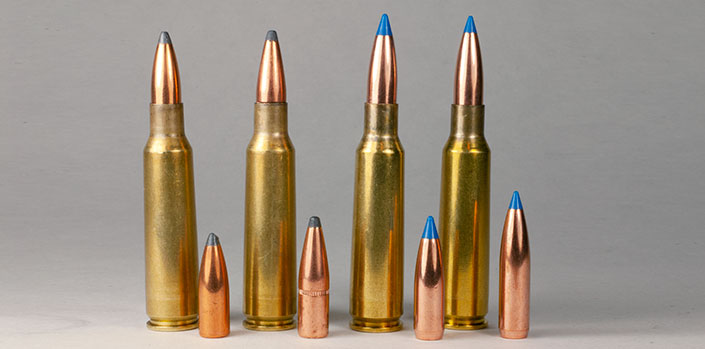
After a century, the sun is setting on the .250-3000 Savage. Many decades ago, though, the Savage cartridge was extremely popular and chambered in a variety of rifles, from bolt-actions, such as the Winchester Models 54 and 70, to the lever-action Savage 99—the rifle to which the cartridge is most often linked. Plenty of those rifles remain in the hands of hunters today because they know the .250’s light recoil lends itself to beneficial practice that culminates in placing a bullet in the correct spot on game.
Charles Newton created the .250 Sav. by shortening a .30-’06 Sprg. case and applying a relatively sharp shoulder angle and long neck, which are prevalent in cartridge design today. If the .250’s case body had slightly less taper, it would be dead ringer for the 6.5 mm Creedmoor, which is oh-so modern. What’s old is new again. Savage introduced the cartridge in 1913 in its Savage Repeating Arms Co. line of ammunition and Savage 1899 Models A, CD and H rifles. In 1918, Savage shortened the name to Model 99.
Initially called .250-3000, the “3000” part of the designation came from the velocity of an 87-gr. bullet, which was astonishing to hunters of the time shooting plodding cartridges, such as the .30-30 Win. and .30-40 Krag. Over the years, the .250 established itself as a hunting cartridge with mild recoil and excellent accuracy. A friend of my father-in-law shot enough coyotes, turning their pelts into cash, in one winter with his Savage 99 .250 to buy a new 1938 Chevrolet sedan.

Twist Fix
Older rifles chambered for the little Savage cartridge have a rifling twist of 1:14" to stabilize 87-gr. bullets. That twist remained standard even after 1933 when the Peters Cartridge Co. introduced a 100-gr. bullet with a muzzle velocity of 2800 f.p.s. Not until about 1961 did Savage change the Model 99’s twist rate to 1:10", and Ruger and Remington selected that twist for the barrels of their bolt-actions in the 1970s and ’80s.
 That slow twist was declared incapable of stabilizing bullets heavier than 87 grs. The eighth edition of the Nosler Reloading Guide states “Many older Model 99s have a 1:14" twist barrel and will not stabilize any of our .25-caliber bullets.” With trepidation on the trigger of the family Winchester Model 54 .250, I shot Nosler 85-gr. Ballistic Tips through the rifle’s 1:14" twist. Several groups at 100 yds. measured well under an inch. The same with 100-gr. Ballistic Tips. However, 115-gr. Ballistic Tips were too much for the rifling to handle, with groups spreading 6" to 10" across.
That slow twist was declared incapable of stabilizing bullets heavier than 87 grs. The eighth edition of the Nosler Reloading Guide states “Many older Model 99s have a 1:14" twist barrel and will not stabilize any of our .25-caliber bullets.” With trepidation on the trigger of the family Winchester Model 54 .250, I shot Nosler 85-gr. Ballistic Tips through the rifle’s 1:14" twist. Several groups at 100 yds. measured well under an inch. The same with 100-gr. Ballistic Tips. However, 115-gr. Ballistic Tips were too much for the rifling to handle, with groups spreading 6" to 10" across.
Factory-loaded .250 Sav. cartridges and cases for reloading are limited today. Hornady Custom cartridges are loaded with 100-gr. InterLock bullets at 2800 f.p.s., and Hornady cases for handloading are readily available through several Internet sites. Hunting Shack sells cartridges loaded with Hornady 75-gr. V-MAX bullets at 3200 f.p.s. and Sierra 100-gr. GameKings at 2900 f.p.s. Remington has its Express cartridges loaded with 100-gr. Pointed Soft Points traveling at 2820 f.p.s. These cartridges, though, are less readily available. Winchester Ammunition lists cases, but they are seldom seen.

Two .250s
The idea for this article fermented in my head after getting my insatiable hands on a Savage 99EG rifle chambered in .250 Sav. The rifle was made in 1953, according to the “E” stamped on its lever boss. The rifle is a pleasure to look at, with the top of the stock grip arcing into the receiver and lever loop linked to a yoke with a contour sweeping up to the receiver base and forward to a tapered barrel held with a slim fore-end with a schnabel tip.
The 99 came with a standard, open rear sight and metal bead front sight on an integral ramp. The front sight fit neatly inside a white 4" circle surrounded by the black border of a target at 100 yds. A few groups revealed my eyesight is less elastic than in years past; all bullets hit about 6" above my point of aim, even with the rear sight at its lowest position. A Marble’s Automatic Flexible Joint aperture rear sight was an accessory from Savage. I removed one from another 99 and installed it on the .250’s receiver, and its arm extended the aperture about an inch back over the grip. The aperture increased the rifle’s sight radius by 9", and I only had to focus on the front bead and then out to the target. Groups measured between 2" and 3".
The Remington Model 700 Classic .250 Sav. was included to show the .250 holds its own in accuracy with any hunting cartridge, and is no sloth in the way of velocity, even with a maximum average pressure of only 45,000 copper units of pressure (c.u.p.). In 1984, the .250 Savage chambering was added to Remington’s limited (1981-2005) run of Classic rifles.

Handloading
In the past, I’ve loaded the Remington and the family Winchester .250s with 85- to 115-gr. bullets with 10 powders from Reloder 15 on the fast side to Reloder 22 on the slow end. Hodgdon’s H4350 produced the highest velocities and best accuracy.
Several suitable powders have come along since then. Examples such as IMR 8208 XBR and Varget produced extreme spreads of velocity between 10 and 29 f.p.s. fired in the Remington, while IMR 4451 produced an extreme spread of 54 f.p.s. for Sierra 87-gr. bullets shot in the Savage 99. With an extreme spread of 29 f.p.s., H4350 remained the powder preference for six Hornady 100-gr. InterLocks shot through the Savage. The propellant also yielded a spread of just 9 f.p.s. for 10 115-gr. Ballistic Tips shot through the Remington and a 1.14" average for three, five-shot groups.
In terms of speed, the .250 Sav. gives up next to nothing compared to popular cartridges of today. The nearly 3000 f.p.s. the Savage achieved with 100-gr. bullets mirrors the velocity of the .243 Win. firing the same weight bullet. The 115-gr. bullets at 2800 f.p.s. from the Remington .250 Sav. is right behind a 6.5 mm Creedmoor shooting 120-gr. bullets at 2900 f.p.s. But everything becomes timeworn.
Just handling a .250 Sav. cartridge brings my mind back to one of the first mule deer bucks I shot as a boy. The buck jumped out of a draw, ran up the ridge and stopped between some trees. I sat with the Winchester .250 and shot the buck broadside. It stumbled down the hill and fell. No memory is as vivid as walking up to that buck through the bright sunshine that afternoon long ago.






































